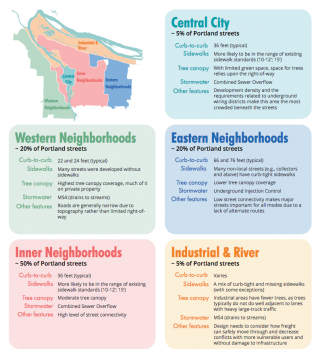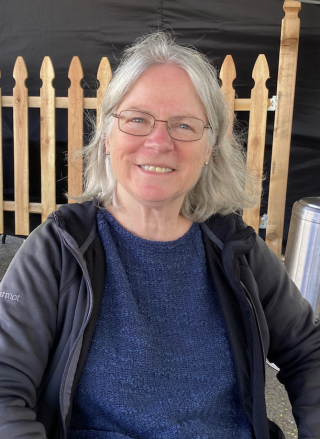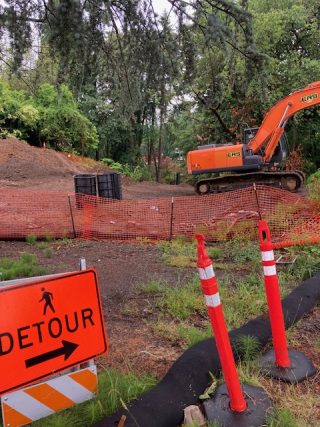
(Photos: Lisa Caballero/BikePortland)
Construction on the $27.5 M SW Capitol Highway: Multnomah Village – West Portland Project begins today. The project will bring protected bike lanes, sidewalks, new crossings, upgraded stormwater management and water pipes to this key north-south corridor through southwest Portland.
The project was conceived in 1993 when neighborhood advocate Marianne Fitzgerald mailed a type-written letter to then-Commissioner Earl Blumenauer promoting the route’s civic importance and lamenting that “pedestrians have worn mud paths” at the side of the road due to lack of sidewalks.
Nearly 30 years later, a Zoom-mediated construction open house last Thursday marked the end the project’s long gestation and laid bare the scope and complexity of the work ahead. Clearly, there is more than meets the eye to constructing a sidewalk and bike lane in an area with limited ROW and non-standard stormwater facilities.
Advertisement
The zoom grid itself was a tip-off. It included twelve city employees—from the Portland Bureau of Transportation, the Bureau of Environmental Services, the Water Bureau and TriMet, as well as the contractor and a representative from the Multnomah Neighborhood Association.
As always seems to be the case, discussions about transportation in Southwest Portland quickly turn into questions of stormwater. Notably, at $12M, BES is the single largest funding source for the project.
So let’s talk about stormwater.
Stormwater

As we reported last week, Streets 2035 Project is a multi-agency effort being led by PBOT which hopes to create a “context-sensitive decision-making framework that guides space allocation in the right-of-way.” It aims, among other things, “to reduce situations that require individual interpretation and inter-bureau negotiation.” “Context-sensitive” in regard to SW Portland means non-standard stormwater facilities and narrow ROW.

That project’s Draft Phase 1 Summary has one of those foundational graphics, titled Existing Conditions in the Right of Way, that helps one understand why Portland is the way it is. It divides the city into five regions according to ROW width and stormwater treatment. The Western Neighborhoods Pattern Area has an “MS4 (drains to streams)” stormwater designation.
I caught up with Marianne Fitzgerald last month to get a better understanding of what that stormwater designation has meant for the Capitol Highway project. She pointed out to me that stormwater treatment is regulated by the Environmental Protection Agency and therefore must adhere to federal standards. According to Fitzgerald, the Capitol Highway project only came together in its current scope in 2016, when BES came forward with the funding to carry the stormwater runoff off-site to four treatment and detention basins. Taking the drainage off-site opened up room in the ROW for bike lanes and sidewalks. (Bike lane- and sidewalk-precluding open drainage ditches are ubiquitous along Southwest Portland roads.)
Thus, getting room to walk and safely ride a bicycle on this particular road was dependent on a major upgrade of stormwater facilities. What surprised me was how beautiful the stormwater basins look in the design. In my ignorance, I was expecting something more industrial, instead these look like placemaking gardens.
Fitzgerald praised Mike Jordan, director of BES, for his “unprecedented cooperation with PBOT.”
The Advocacy Relay

“I’m very, very happy about it.”
— Marianne Fitzgerald
Fitzgerald described the project as a “true community effort, a lot of leveraging, a lot of seizing the moment,” and she was quick to give credit to others. I know I have missed some of the names she mentioned, but Steve Novick received special credit for championing the 10-cent gas tax which provided the “Fixing Our Streets” seed money to leverage other funds, and project manager Steve Szigethy of PBOT for being “great to work with.”
She mentioned Chris Lyons several times as being the community volunteer who had put in the most effort these past few years. Lyons is the chairman of the Capitol Highway sub-committee of the Multnomah Village neighborhood association. As such, he has been the liaison between the neighbors and the city bureaus and “brought along all the property owners who had mixed feelings.” This was no small feat. The project involved ROW negotiations for 90 easements/acquisitions and over 60 property owner visits. His efforts showcase how a well-run neighborhood association can be an invaluable community partner to the public works bureaus.
Fitzgerald summed up her feelings, “this is participatory democracy, everyone had a voice. I’m very, very happy about it.”
For more project information, including construction schedule and detours, please see the Capitol Highway Project web page.
In other southwest Portland news . . .

Construction also began this spring on the Red Electric bridge and trail at the Hillsdale end of SW Capitol Highway. The project is expected to be complete in the spring of 2022.

— Lisa Caballero, lisacaballero853@gmail.com
— Get our headlines delivered to your inbox.
— Support this independent community media outlet with a one-time contribution or monthly subscription.

